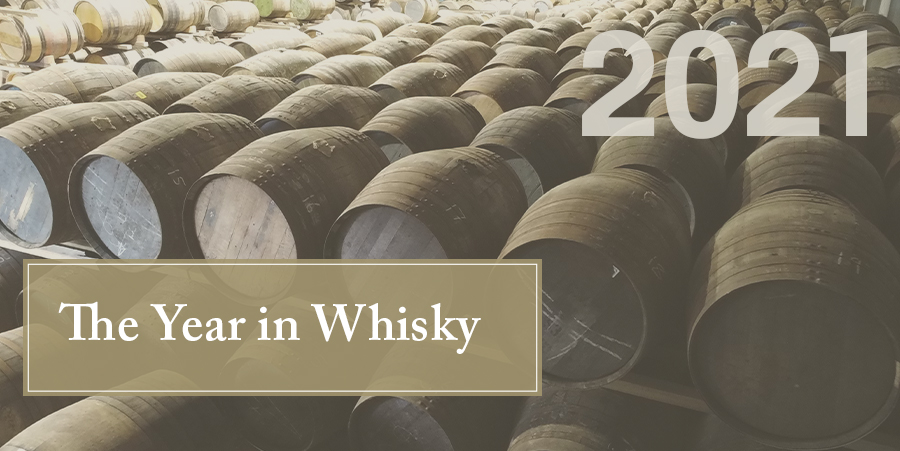As the final days of 2021 start to melt away like the ice in your glass, thoughts turn to the year about to come to an end. What have the last 12 months meant for whisky investors? And what can we expect for the year ahead?
Recovery and Confidence
After a tough 2020, which saw exports drop by almost 31% compared to the record-breaking sales of 2019, the year began with something of a gloomy outlook for the whisky industry in general. Exports of Scotch Whisky to the EU fell in the first three months of 2021 as lockdowns on the continent continued and producers adjusted to new post-Brexit trading arrangements.
However, good news arrived in June 2021 from the US with the lifting of the 25% tariff on Single Malt Scotch Whisky, imposed as a result of the long-running dispute with European aircraft manufacturers. Despite this, exports of Scotch Whisky to the US for the first half of 2021 remained down by 34% when compared to the same period in 2019. Nevertheless, exports to the whisky industry’s biggest market began to pick up again towards the end of the year.
Sales to markets in Asia, on the other hand, grew in the first half of 2021. In fact, during the first half of the year, China already surpassed the £89m imported in the whole of 2019 – growing 126% to £91m.
As the US and European markets recover and Asia continues to grow, the acceleration of global sales throughout the second half of 2021 bodes well for the coming year.
Diversity and inclusion
March 2021 saw the launch of the Scotch Whisky Association’s Inclusion and Diversity focus group, part of an industry-wide workplan to ‘boost equality, diversity and inclusion’ in all areas of whisky.
The influence of women like Diane Farrell, Senior Site Manager at the Talisker Distillery, Kirsteen Cambpell, Master Whisky Maker, at The Macallan and Annabell Thomas, founder and CEO of the organic distillery Mc’nean, continued to be felt in 2021. This new generation of young female entrepreneurs and distillers promises to bring a fresh focus to an industry that has traditionally been older and male dominated.
Sustainability trends
In 2021, conversations around sustainability gained momentum. There was growing awareness of the whisky industry’s carbon footprint and further efforts to mitigate its impact on the environment. Many large distilleries released plans showing their roadmaps and commitment towards sustainability policies. Bruichladdich on Islay announced plans to make their distillation process net zero by 2025 while the organic whisky brand Mc’nean became the first distillery to become completely carbon neutral.
Even the bigger brands started to make a contribution: in early August Diageo, the biggest producer of scotch, announced plans to install a 4MW solar farm near its packaging plant in Fife, featuring 12,000 solar panels.
New distilleries continue to arrive
A sure sign of the health of the Scotch whisky industry was the arrival of a number of new distilleries in 2021. 8 Doors became the first distillery to produce whisky in John O’ Groats in over 180 years, while Diageo woke up the famous Brora Distillery from its 35-year slumber. Other new additions to the list of Scotland’s distilleries include the Rosebank distillery in Falkirk and the Ardgowan distillery near Glasgow, both currently putting the finishing touches to their shiny new stills.
Aside from the new distilleries, the opening this year of the spectacular flagship Johnnie Walker Experience in Edinburgh promises to become a place of pilgrimage for whisky lovers.
Whiskies to remember
Recent trends in single malt that became increasingly evident in 2021 included the increasing popularity of no-age statement whiskies and the growth of natural, non-chill filtered whiskies.
Whisky lovers were spoilt for choice for quality releases with some great drams to be enjoyed in 2021. Ardbeg Uigeadail was awarded the top prize at the International Whisky Competition in Las Vegas, while The Glenallachie 10 (Batch 4) picked up the prize at the World Whisky Awards. Other drams that caught the eye in 2021 were the Glenmorangie Vintage 1997 and the Glenfiddich 21-Year-Old Reserve Rum Cask Finish.
Cask investment continues to grow
In whisky investment, analysts noticed a slight move away from the highest-price bottles to mid-tier investments. In the Whisky cask market, this tendency could also be seen in the growing popularity of younger and new make casks compared to the more expensive casks on the market.
Despite economic headwinds during the first half of 2021, whisky cask investors saw remarkable stability in their investments, with the BC20 Index showing a projected annual growth of 12.84%, almost identical to that reported at the start of 2021 (when average annual growth was 12.76%).
The reliability of the whisky cask investment market throughout the year contrasted with other investment vehicles, like stocks, gold or crypto, which saw large swings in 2021. As inflation began to bite and an increasing amount of investors of all ages and profiles started looking around for alternative homes for their money, whisky casks became an increasingly popular choice.
The whisky year to come
As we raise our glasses on Hogmanay and welcome the new year, whisky cask investors can look back with satisfaction on performance over the last twelve months. With uncertainty once again surrounding the global economy, tangible assets are likely to become even more popular as a hedge against inflation and a secure way for investors to grow their wealth in 2022.
No one can predict the future, but whatever happens over the next twelve months, the whisky cask market is likely to go from strength to strength.


